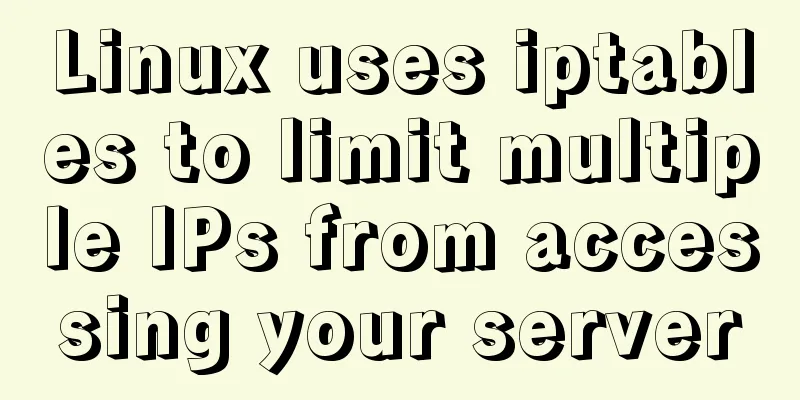Linux uses iptables to limit multiple IPs from accessing your server

|
Preface In the Linux kernel, netfilter is a subsystem responsible for packet filtering, network address translation (NAT), and connection tracking based on protocol types. This subsystem consists of some packet filtering tables, which contain the rule sets used by the kernel to control packet filtering processing. iptables is a tool for managing netfilter. Multiple consecutive IP operations 1. Split into multiple commands to run iptables -A INPUT 192.168.122.2 -j ACCEPT iptables -A INPUT 192.168.122.3 -j ACCEPT iptables -A INPUT 192.168.122.4 -j ACCEPT iptables -A INPUT 192.168.122.5 -j ACCEPT .... This method requires writing many commands, and will make the iptables table very long and difficult to manage. Moreover, a large number of commands will have a small (negligible) impact on performance.
2. Access control can be performed on the IP of an IP segment in the form of IP/MASK This method requires calculating the specified source code for the IP range, which is not flexible. (Although many users use this method for convenience, excessive authorization will pose a security risk) 3. iptables has many modules, among which iprange is used to specifically handle access control of continuous IP segments iptables -A INPUT -m iprange --src-range 192.168.122.2-192.168.122.34 -j ACCEPT #match source IP iptables -A INPUT -m iprange --dest-range 8.8.8.2-8.8.8.22 -j DROP #match the target IP This method is more flexible. There is no need to calculate the mask, just give the range directly. Summarize Currently, the official does not seem to support discontinuous IPs, but some people have added modules to support discontinuous IPs. Personally, I think that if you want to manage the iptables list well, you still have to organize it first and then restrict it. If you need to use continuous IPs, use the above method. If they are not continuous, you should write multiple commands honestly. Moreover, if there are more machines, you have to install modules, which may affect the stability of the system. recommend: Interested friends can follow the editor’s WeChat public account [ Coder’s Stuff ] for more web page production special effects source code and learning materials! ! ! The above is what I introduced to you about using iptables in Linux to limit multiple IPs from accessing your server. I hope it will be helpful to you. If you have any questions, please leave me a message and I will reply to you in time. I would also like to thank everyone for their support of the 123WORDPRESS.COM website! You may also be interested in:
|
<<: MySQL Optimization: Cache Optimization
>>: MySQL optimization connection optimization
Recommend
Native JavaScript to achieve the effect of carousel
This article shares the specific code for JavaScr...
The perfect solution for highlighting keywords in HTML
I recently encountered a feature while working on...
Beginners learn some HTML tags (2)
Related article: Beginners learn some HTML tags (1...
A brief analysis of different ways to configure static IP addresses in RHEL8
While working on a Linux server, assigning static...
Implementation script for scheduled database backup in Linux
Table of contents Scenario: The server database n...
Django+vue registration and login sample code
register The front-end uses axios in vue to pass ...
About debugging CSS cross-browser style bugs
The first thing to do is to pick a good browser. ...
Node.js makes a simple crawler case tutorial
Preparation First, you need to download nodejs, w...
Native js to implement form validation function
Table of contents When developing, analyzing the ...
Several ways to store images in MySQL database
Usually the pictures uploaded by users need to be...
How to enable slow query log in MySQL
1.1 Introduction By enabling the slow query log, ...
VMware Workstation installation Linux system
From getting started to becoming a novice, the Li...
Use of nginx custom variables and built-in predefined variables
Overview Nginx can use variables to simplify conf...
Summary of react basics
Table of contents Preface start React Lifecycle R...
Vue Basics Introduction: Vuex Installation and Use
Table of contents 1. What is vuex 2. Installation...










